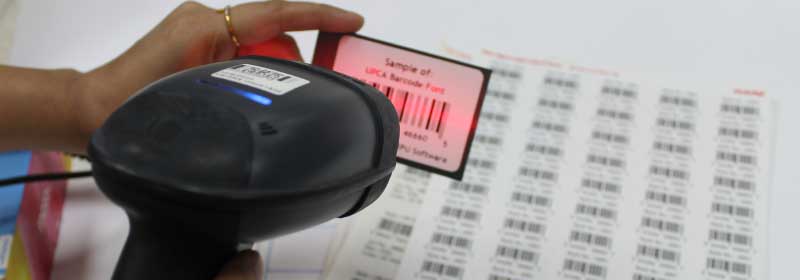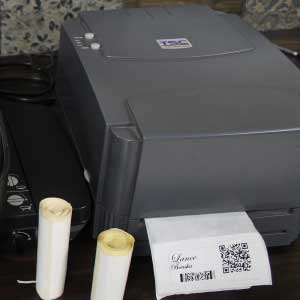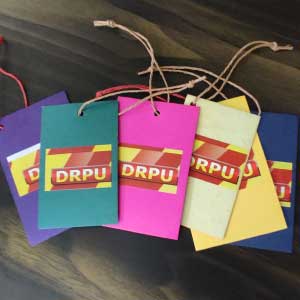Benefits Of using Business Barcode Systems
Business barcodes help improve efficiency and accuracy in a variety of business processes, making it easier for businesses to manage inventory, process orders, track assets, and monitor employee time and attendance.

Business Barcode Help to Improve Efficiency, Accuracy and Inventory Management
-
Item Identification: Barcodes provide a unique identifier for each item, making it easy to track items from the moment they are received to the moment they are sold or used. Barcodes can also include information such as product name, price, and manufacturer, which can be used to manage inventory levels and optimize purchasing decisions.
-
Stock Control: Barcode systems enable businesses to monitor inventory levels in real-time, reducing the likelihood of stockouts or overstocking. By scanning barcodes, businesses can quickly and accurately update inventory levels and track the movement of stock.
-
Asset Tracking: Barcodes can be used to track the location and movement of assets such as equipment, vehicles, and tools. By scanning the barcode, businesses can quickly and easily track the location of assets, reducing the likelihood of lost or stolen items.
-
Data Accuracy: Barcode systems help ensure data accuracy by eliminating the need for manual data entry. By scanning barcodes, businesses can ensure that data is entered correctly and quickly, reducing the likelihood of errors and improving efficiency.
-
Inventory Management: Barcodes enable businesses to keep track of their inventory in real-time, reducing the likelihood of stockouts and overstocking. By scanning barcodes, businesses can monitor stock levels, identify low-stock items, and replenish inventory in a timely manner.
-
Order Processing:Barcodes can be used to process orders more efficiently, reducing errors and speeding up the fulfillment process. When orders are received, they can be scanned into the system, and the barcode can be used to track the order throughout the fulfillment process, from picking and packing to shipping and delivery.
-
Time and Attendance: Barcodes can be used to track employee time and attendance, reducing the likelihood of time theft and ensuring that employees are paid accurately. Employees can scan their barcodes when they arrive at work, take breaks, and leave for the day, making it easy to track their hours and calculate their pay.
-
Order Fulfillment: Barcode systems can be used to process orders more efficiently, reducing errors and speeding up the fulfillment process. By scanning barcodes, businesses can monitor stock levels, identify low-stock items, and replenish inventory in a timely manner.
Choose The Right Barcode Software For Your Business Needs
Choosing the right barcode software for your business needs can be a daunting task, but there are a few key factors to consider:
-
Compatibility:
Make sure the barcode software is compatible with your operating system and any other software you may be using.
-
Ease of Use:
Look for software that is user-friendly and easy to navigate, especially if you or your staff are not experienced with barcode technology.
-
Customizability:
Choose software that allows you to customize the barcode labels to fit your specific needs, such as size, font, and layout.
-
Barcode Types:
Make sure the software supports the type of barcode symbology you need for your business.
-
Support:
Look for software that offers reliable technical support, updates, and training resources.
-
Cost:
Evaluate the cost of the software in relation to your budget and the features you need.
-
Integration:
Consider whether the software can integrate with other systems or software you may be using, such as inventory management or point-of-sale (POS) systems.
Conclusion: By considering these factors, you can make an informed decision about the barcode software that will best suit your business needs.
Choose The Right Barcode Printer For Your Business Needs
Choosing the right barcode printer for your business needs requires consideration of several factors, including the volume and type of printing you will be doing, the environment in which the printer will be used, and your budget. Here are some key factors to consider when choosing a barcode printer:

-
Volume of Printing: Consider the volume of printing you will be doing. If you are printing a small number of labels each day, a desktop barcode printer will suffice. If you are printing hundreds or thousands of labels per day, you may need a larger, industrial-grade printer.
-
Type of Printing: Think about the type of printing you will be doing. Do you need to print high-quality labels with intricate graphics or small font sizes? If so, you may need a printer with a high resolution, such as a thermal transfer printer. If you are printing simple barcodes with no graphics, a direct thermal printer may suffice.
-
Environment: Consider the environment in which the printer will be used. If the printer will be used in a warehouse or other harsh environment, you may need a printer that is more durable and able to withstand dust, moisture, and extreme temperatures.
-
Connectivity: Determine how you will connect the printer to your computer or network. Some printers offer USB, Ethernet, or wireless connectivity options, while others require a serial connection.
-
Budget: Finally, consider your budget. Barcode printers can range in price from a few hundred dollars to several thousand dollars, so it's important to choose a printer that fits within your budget.
Choose The Right Barcode Label Maker for Your Business Needs
Choosing the right Barcode Label Maker for your business needs depends on a number of factors such as the volume of labels you need to create, the level of customization required, the types of barcodes you need to create, and your budget. Here are some considerations to keep in mind when selecting a Barcode Label Maker

-
Volume: If you only need to print a small number of labels, you may be able to use a basic label maker that prints one label at a time. If you need to print labels in large quantities, you may want to consider a label maker that can print multiple labels at once.
-
Customization: Consider the level of customization you require for your labels. Some label makers offer basic customization options such as font size and style, while others allow you to customize the design of the label.
-
Barcode Types: Some label makers are designed to print specific types of barcodes, such as QR codes or UPC codes. Make sure the label maker you choose can print the type of barcode you need.
-
Budget: Barcode Label Makers are available at a range of price points, so consider your budget when selecting a label maker.
-
Compatibility: Make sure the Barcode Label Maker you choose is compatible with your computer and any other systems you plan to integrate it with.
-
Ease Of Use: Consider the ease of use of the label maker and any software required to operate it. A user-friendly interface and intuitive software can save time and frustration.
Conclusion: By keeping these factors in mind, you can choose the Barcode Label Maker that best fits your business needs.
Business Workers Ensure The Accuracy And Quality Of The Information Encoded In Barcodes
Business workers can ensure the accuracy and quality of the information encoded in barcodes by following these best practices:
-
Use Reliable Barcode Software:
To generate barcodes with accurate information. Barcode software can automatically check for errors, ensuring that the data entered is correct.
-
Verify The Information:
Before creating or printing the barcode, double-check the information to ensure it is accurate. This includes checking for spelling errors, incorrect data, and missing information.
-
Test The Barcode:
It using a barcode scanner or reader to ensure that the data is correctly encoded and that the barcode can be read accurately.
-
Use High-Quality Printing:
This techniques to ensure that the barcode is printed clearly and with a high level of contrast, making it easier to scan.
-
Avoid Obstructions:
Avoid placing barcodes in areas where they may become obstructed, such as around folds, bends, or curves. This can make it difficult for scanners to read the barcode.
-
Train Employees:
Train employees on the importance of accurate barcode information and how to properly create and print barcodes. This can help ensure that everyone follows best practices and maintains high levels of accuracy.
Conclusion: By following these best practices, business workers can help ensure the accuracy and quality of the information encoded in barcodes, which can improve efficiency and accuracy in the processing and delivery of packages, inventory management, and other business processes.